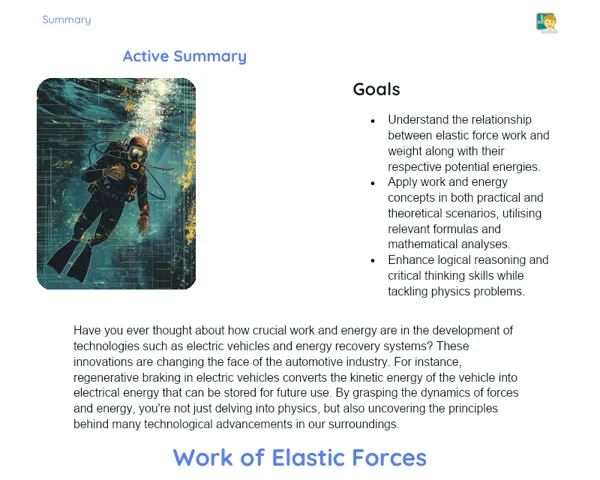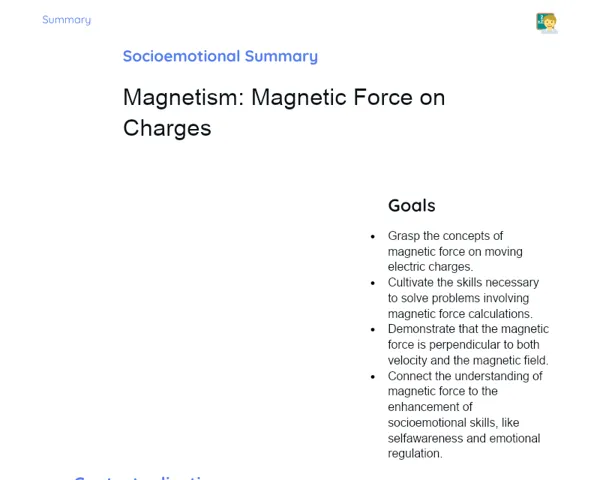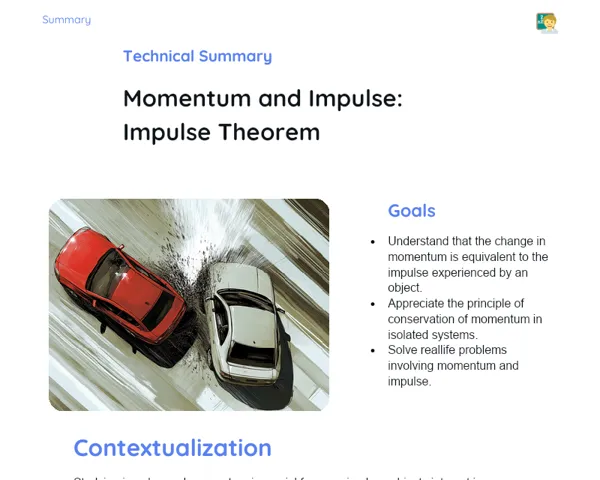Summary Tradisional | Kinematics: Centripetal Acceleration
Contextualization
Kinematics is a branch of Physics that focuses on the motion of objects without delving into the reasons behind that motion. Circular motion stands out as a key topic in this field, given its relevance in both natural phenomena and modern technology. Centripetal acceleration is a vital aspect of circular motion; it is the acceleration that ensures an object follows a circular path, always directed towards the center of that path.
Understanding centripetal acceleration is crucial for comprehending how things like cars navigating corners, thrilling amusement park rides, and even planets orbiting the Sun behave. For instance, during a car's turn, it is the centripetal acceleration that keeps the vehicle on the curved trajectory, preventing it from veering off in a straight line due to inertia. Likewise, centripetal acceleration is imperative for Earth and other planets to maintain their orbits around the Sun, ensuring the harmony of our solar system.
To Remember!
Definition of Centripetal Acceleration
Centripetal acceleration is the acceleration that keeps an object following a circular path, pointing always towards the center of the trajectory. This type of acceleration is essential to continuously alter the direction of the object's velocity, ensuring it remains in circular motion. Without it, an object moving in a circle would simply travel straight due to inertia.
Centripetal acceleration differs from linear acceleration, which involves changes in velocity along a straight line. In circular motion, it is perpendicular to the object's tangential velocity, which leads to a continuous change in direction while maintaining the same speed.
For instance, think of a car making a turn. Centripetal acceleration is what keeps the vehicle on that curve, continuously steering it towards the center of the turn. Similarly, it's this acceleration that enables planets to orbit the Sun, preventing them from drifting away in a straight line due to inertia.
-
Centripetal acceleration always points towards the center of the circular path.
-
It is essential for maintaining an object in ongoing circular motion.
-
Unlike linear acceleration, it changes direction while keeping the speed constant.
Centripetal Acceleration Formula
The formula for centripetal acceleration is expressed as a_c = v² / r, where 'a_c' represents centripetal acceleration, 'v' denotes the tangential velocity of the object, and 'r' is the radius of the circular path. This formula illustrates that centripetal acceleration is directly proportional to the square of the tangential velocity, while being inversely proportional to the radius of the trajectory.
In other words, for a circular motion scenario, the greater the tangential velocity, the more centripetal acceleration is needed to keep the object on its circular path. Conversely, a smaller radius necessitates a higher centripetal acceleration for any given tangential velocity.
For example, when a car takes a sharp turn at high speed, the centripetal acceleration is significantly greater than when it makes a gentler turn or moves at a slower pace. Understanding this relationship is key to grasping the dynamics of circular motion in various contexts, ranging from vehicles navigating curves to planetary orbits.
-
Centripetal acceleration formula is a_c = v² / r.
-
Centripetal acceleration is directly related to the square of the tangential velocity.
-
Centripetal acceleration is inversely related to the radius of the trajectory.
Practical Applications of Centripetal Acceleration
Centripetal acceleration has numerous practical applications that are vital for safety and efficiency across various systems. In vehicles, understanding centripetal acceleration is paramount for safe turns. Without this force, vehicles would be unable to navigate corners safely, as inertia would push them straight ahead.
Amusement park rides such as roller coasters and merry-go-rounds also showcase the importance of centripetal acceleration. It's what keeps passengers securely in their seats despite rapid movements and sharp turns. The engineering behind these rides relies heavily on precise calculations of centripetal acceleration to ensure the safety of thrill-seekers.
Additionally, centripetal acceleration plays a key role in the planet's orbit. The gravitational force acts as the centripetal force, securing planets in their orbits around the Sun. In the absence of this force, planets would shoot off in a straight line, escaping the solar system's gravitational pull. Thus, centripetal acceleration is fundamentally important for the stability and functionality of our solar system.
-
Centripetal acceleration is crucial for vehicle safety during turns.
-
Amusement park rides are designed considering centripetal acceleration to ensure passenger safety.
-
Centripetal acceleration is vital for maintaining planetary orbits around the Sun.
Difference Between Centripetal Force and Centripetal Acceleration
While centripetal force and centripetal acceleration are interconnected, they are distinct concepts. Centripetal force is the net force that produces centripetal acceleration, maintaining an object in circular motion. This force always points inward, towards the center of the circular path, and can be attributed to various types of forces—such as gravitational, frictional, or tension forces.
Centripetal acceleration, in contrast, is the acceleration that results from this centripetal force. It also points towards the center of the circular path and is responsible for the continuous alteration of the object’s velocity direction, ensuring it follows the circular track. The connection between centripetal force and centripetal acceleration is defined by Newton’s second law: F_c = m * a_c, where 'F_c' indicates the centripetal force, 'm' the mass of the object, and 'a_c' the centripetal acceleration.
Take, for example, a car navigating a turn. Here, the frictional force between the tires and the road acts as the centripetal force that generates the centripetal acceleration keeping the car on its curved path. Similarly, gravitational force functions as the centripetal force that keeps planets orbiting the Sun.
-
Centripetal force is the overall force that leads to centripetal acceleration.
-
Centripetal acceleration is the result of the applied centripetal force.
-
The relationship between centripetal force and centripetal acceleration is defined by F_c = m * a_c.
Key Terms
-
Kinematics: The study of motion of objects without considering the causes behind it.
-
Centripetal Acceleration: The acceleration that keeps an object moving in a circular path, always directed towards the center.
-
Tangential Velocity: The speed of an object in circular motion measured along the path.
-
Radius of Trajectory: The distance from the center of the circular path to the moving object.
-
Centripetal Force: The resultant force that causes centripetal acceleration, maintaining circular motion.
Important Conclusions
In this lesson, we delved into the concept of centripetal acceleration, a critical factor in keeping an object in circular motion. We learned that it consistently points towards the center of the trajectory and ensures a continual change in direction of the object's velocity, without affecting its speed. Moreover, we discussed the centripetal acceleration formula, which relates the object's tangential velocity to the radius of the circular path, and explored its applications in various practical scenarios.
We also highlighted the practical implications of centripetal acceleration, from ensuring vehicle safety during turns to the operation of amusement park attractions, alongside the orbits of celestial bodies around the Sun. This knowledge is fundamental in understanding how objects behave in circular paths and in designing systems that are both safe and effective.
Finally, we clarified the distinction between centripetal force and centripetal acceleration. While centripetal force is the resultant force producing centripetal acceleration and can stem from different sources like gravity or friction, comprehending this difference is vital for appropriately applying these concepts in practical situations and analyzing circular motions.
Study Tips
-
Review the formula for centripetal acceleration and practice solving problems with varying radii and tangential velocities to solidify your understanding.
-
Investigate real-life examples of centripetal acceleration, such as amusement park rides or planetary orbits, to better visualize the practical applications of the concept.
-
Engaging in discussions with peers or joining study groups can enhance clarity and deepen your grasp of the topics covered in class.



